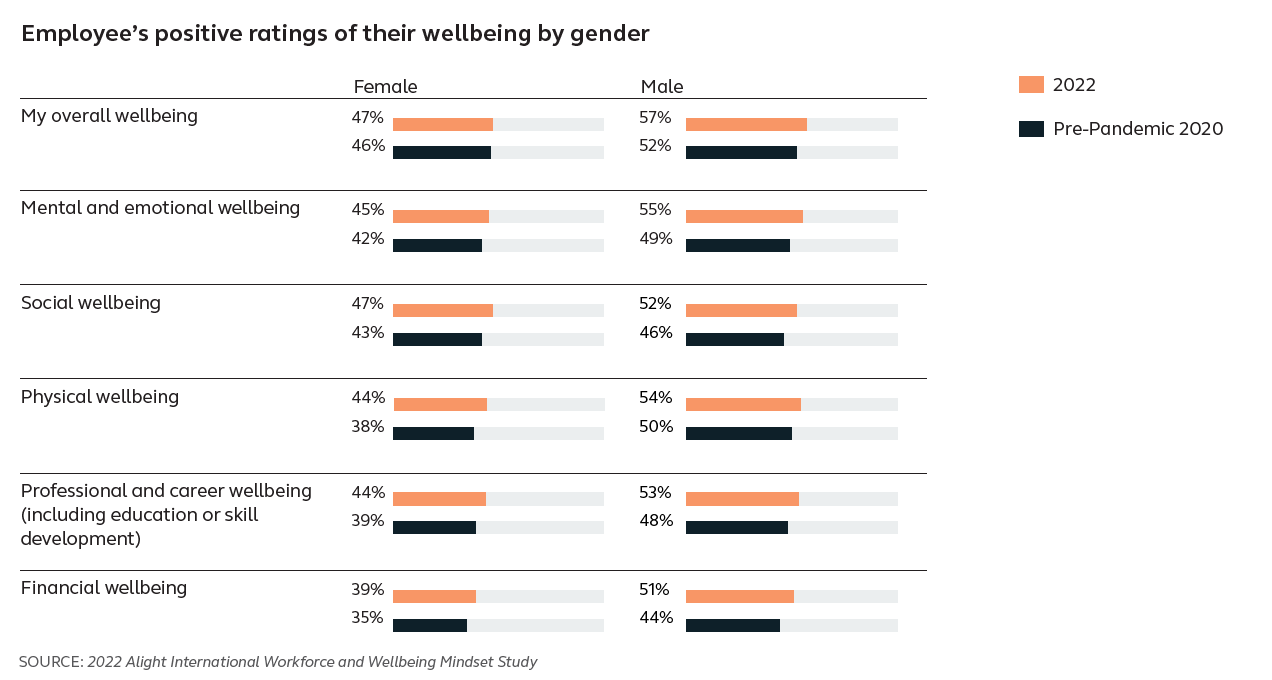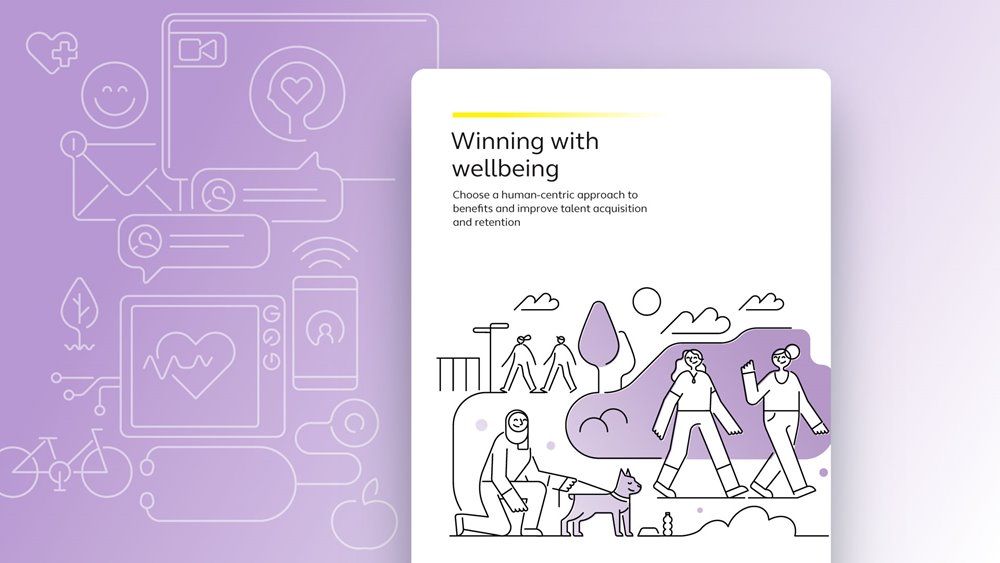Wellbeing is the cornerstone of our lives. When we perceive our wellbeing positively, we reap many benefits, including reduced incidences of cardiovascular disease, stroke and sleeping problems.i We also experience a boost in productivity and creativity in both our professional and personal lives.i In short, having high levels of wellbeing helps us to be our best selves. ii
Promoting wellbeing at work creates a positive environment and helps employees thrive. Recognizing this fact, employers have increased their investments in wellbeing programs and resources. The total budget for wellbeing programs increased about 22% in 2021, with the average budget per employee reaching $238.iii
Those investments were paying off in the form of improved wellbeing ratings before the arrival of the pandemic. All wellbeing measures took a hit because of COVID, but recent metrics show perceptions improving. It’s incumbent upon employers to ensure those numbers continue trending upward. Fortunately, employees have indicated they would welcome assistance from their employer. Through tech-enabled guidance and support, employers can empower employees to make confident decisions that will improve their wellbeing.
The importance of wellbeing
The concept of wellbeing is said to date back to Aristotle, who considered the idea of Eudaimonia — flourishing and living well — imperative to the human condition.iv At Alight, we define wellbeing as the ability to live one’s best life at work and at home.
Our Wellbeing Framework lays out the four components of wellbeing: healthy mind, healthy body, healthy wallet and healthy life — that is, living your purpose and having meaningful connections. These four components are intricately intertwined and interdependent.
In the workplace, the impact of wellbeing is significant. When an employee’s wellbeing is poor, they get burned out easily, struggle to perform their duties and are more likely to leave the company. When their wellbeing is thriving, they take fewer sick days, perform at a higher level and have lower rates of burnout and turnover. v
Increasingly, employers are recognizing the role they play in helping their workforce achieve optimum wellbeing. According to the 2022 Alight International Workforce and Wellbeing Mindset Study, progress had been made across all measures – until COVID-19 reared its ugly head.vi
The COVID effect
With awareness of the importance of wellbeing on the rise, employers implemented an array of programs, resources and support tools to help employees live their best lives. They moved beyond the basics of gym memberships, health insurance and 401(k) plans into more robust offerings. From disease management and stress reduction to personalized financial planning and health navigation assistance, employers went all-in on wellbeing.
By the first half of 2020, these investments were paying off handsomely, with 49% of employees rating their overall wellbeing positively, according to Alight’s 2020 Employee Wellbeing Mindset Study.
Participants felt most positive about their mental and emotional wellbeing and least positive about their financial wellbeing. Unfortunately, all aspects of wellbeing took a major hit with the arrival of COVID-19. According to the 2022 Mindset Study, overall wellbeing plummeted nine points in just one year to 40% in 2021.
The World Health Organization (WHO) declared the novel coronavirus (COVID-19) outbreak a global pandemic on March 11, 2020. Immediately, fear and anxiety set in, as people worried the virus would infect themselves or someone they loved.
With lockdowns spreading across many cities and states, people were asked to stay home to slow the spread. The resulting isolation only compounded the emotional difficulties many were already experiencing. Working from home, often while overseeing their children’s schooling or engaged in caregiving for an ailing family member, heightened stress levels for many employees.
The impact on wellbeing was substantial, with 4 in 10 workers saying the pandemic caused their emotional and mental wellbeing to decline.vii Consequently, the number of employees with a positive view of their mental/emotional wellbeing fell from 46% in 2020 to 39% in 2021. viii
Unhealthy habits emerge
While some people used their time in lockdown to establish new exercise routines, bask in the joy of a long walk or simply romp outside with the family, others adopted unhealthy habits. Alcohol consumption soaredix and waistlines expanded.x
Meanwhile, limited access to healthcare and fear of contracting COVID-19 in a doctor’s office or hospital led to precipitous drops in cancer screenings and preventative care, further threatening the physical wellbeing of millions of people.xi Most concerning were the reports of people experiencing symptoms of stroke or heart attack who refused to seek medical care because they were concerned they would be exposed to COVID in the emergency room. xii
All these converging factors led to a six-point decline in the number of employees viewing their physical wellbeing positively, from 44% in 2020 to 38% in 2021. viii
Throughout the pandemic, U.S. households struggled to stay afloat financially. Faced with possible job loss or a significant reduction in income, many Americans found it nearly impossible to pay their rent or mortgage, put food on the table or cover other routine expenses. Nearly 40% reported serious difficulties paying utility bills or credit card debt. Roughly one-fifth depleted their savings, leaving them nothing to fall back on.xiii
Latino, Black and Native American households were disproportionately impacted, as were residents of rural America, where 43% reported adult household members had lost their jobs, been furloughed or had wages or hours reduced during the pandemic. Two-thirds of rural households (66%) experienced serious financial problems.xiv Not surprisingly, the number of employees feeling good about their financial wellbeing fell five points from a high of 40% in 2020 to an abysmal 35% in 2021.
Overall wellbeing improving
While COVID has yet to completely release its grasp — and likely never will, according to many scientistsxv — the return to some semblance of normalcy has Americans generally feeling better about their wellbeing. Across the board, 53% of employees now rate their overall wellbeing positively, up from a low of 40% at the height of the pandemic.viii Drilling down into those findings, we see significant improvements in employee perceptions across all aspects of wellbeing:
Generational differences
Overall wellbeing is at its highest rating in five years. Unfortunately, however, some demographic groups are feeling far less optimistic. Among Generation Z, for example, just one-third report feeling positive about their overall wellbeing.viii
Most concerning, only 28% feel good about their mental and emotional wellbeing, while even fewer (27%) are confident about their financial wellbeing. While Millennials, Gen Xers and Boomers have had time to build up a financial safety net, Gen Z adults have only been in the workforce a few years and are unlikely to have sufficient savings to tap. According to a study by the Urban Institute, 38% have considered turning to payday lenders to cover ongoing costs like transportation or rent. The high cost of dealing with such predatory lenders is likely to negatively impact their financial security and further limit their ability to weather future economic difficulties.xv
Interestingly, the generation that directly preceded Gen-Z is feeling the most positive. With the exception of financial wellbeing, Millennials are well above the 50% mark on all measures. And when it comes to their finances, they’re feeling more optimistic than all other generations. While they’re often characterized as job-hopping spendthrifts — $9 avocado toast, anyone? — an Investopedia study revealed Millennials feel knowledgeable about their finances, including saving, managing a budget and paying taxes. They feel confident when making financial decisions, engage in new financial practices like buying cryptocurrency and actively seek out financial content online. xvii
By comparison, Boomers rate their wellbeing lower than Millennials across all measures, including — surprisingly — financial wellbeing. According to a study by the Center for a Secure Retirement, 41% of Boomers financially supported family members during the pandemic, negatively impacting their own retirement plans. Of those Boomers who opened their wallets to lend their loved ones a hand, threequarters (75%) said they were unable to save as much as a result. More than half expressed concern they may never be able to retire now.xviii
Gender gap persists
When it comes to gender, both men and women rated their wellbeing better in 2022 than in 2020. However, men rated themselves higher than women across all categories, especially in financial wellbeing, where more than half of men feel confident about their financial security.
Historically, women have lagged behind their male counterparts in saving for retirement. There are a number of theories for why this occurs. Women tend to make less money and take time-outs from the workforce more often to perform caregiving duties. They also have longer life expectancies, making it imperative that they build a big enough nest egg to cover their expenses in retirement. Yet women are feeling not-so-great when it comes to their financial wellbeing.
That’s not to suggest there hasn’t been improvement. The number of women rating their financial wellbeing as positive ticked up from 40% in 2020 to 45% in 2022.viii Still, the long-term financial outlook for the majority of women looks bleak. The median retirement savings for women is just $21,000, compared to $41,000 for men.xix Nearly one-third of women have no retirement savings at all. That’s almost double the number of men facing the same predicament.xx

Opportunity is knocking
While it’s encouraging that employee perceptions of their wellbeing have experienced a post-pandemic rebound, there is clearly room for improvement, especially among women and members of Gen Z. This presents a tremendous opportunity for employers to provide their workers with guidance and support that reflects the unique needs of individual employees. One size does not fit all, making it imperative that employers offer technology-enabled, personalized support, along with high-touch navigation services, to meet employees in the moment and help them make confident decisions that will impact all aspects of their wellbeing. Fortunately, most employees are willing to accept help that will empower them to be in control of their own decisions.
According to the 2022 Mindset Study, three-quarters of employees said they are open to personalized outreach and support from a qualified nurse if they receive a medical diagnosis. Meanwhile, two-thirds of employees consider valuable tools that create cost clarity, health plan comparison or provide choice. Not surprisingly, employees expressed strong interest in receiving assistance with financial matters. Roughly half of all employees want either a “bit of help” or specific advice when it comes to everything financial. That represents a significant increase year-over-year and an opportunity for employers to step up and deliver on employee expectations.
A personalized, tech-enabled approach across all aspects of wellbeing empowers employees to take better control of their health. Through a combination of Artificial Intelligence (AI) and high-touch navigation support and guidance, employees gain the ability to make confident decisions that directly impact their physical, emotional and financial wellbeing. Personalizing the experience based on each employee’s unique situation and life stage ensures more meaningful interactions and increased engagement with their wellness benefits. This transformation will help build upon their post-pandemic gains and set themselves up for better wellbeing in the future.
What you can do now
Wellbeing will continue to be a challenge as people struggle to achieve Eudaimonia in their lives. Fortunately, there are steps you can take to help workers improve their wellbeing now and in the future.
- Ensure equal access to benefits and resources. Many benefits designed to improve
wellbeing are seriously underutilized. Evaluate why those who are eligible are not taking
advantage of their benefits and work to eliminate the barriers to using them. - Adopt a life stage approach. Recognizing people have different needs for wellbeing
resources as they make their way through life, employ targeted communications to deliver
timely recommendations that are most helpful for where they are in life. - Strive to meet your commitment to diversity, equity and inclusion at all levels of the
organization. Employees want to work for companies that commit to ensuring fairness
in hiring, pay and promotions and to cultivating a workplace free of discrimination,
harassment and bias. They also want leaders that mirror the diversity of their customer
and employee bases. For more information take a look at our Winning with Wellbeing
report. - Support your people in times of crisis with resources and policies that allow them
to care for their physical, emotional and financial health, including time-off to care for a
family member or navigate traumatic situations. - Build high levels of trust. Employees are more likely to accept your help with their
wellbeing when they recognize that you have their best interests at heart. Trust is a crucial
component in the employee-employer relationship.
The American workforce has endured a rough couple of years as the COVID-19 pandemic caused widespread challenges, grief and fear. Yet employees persevered, thanks to employers who were committed to keeping them safe and financially secure. As we emerge from the pandemic and face new challenges, employees are feeling better across all measures of wellbeing, although there is still a long way to go. Through personalized guidance and resources, employers empower the workforce to make confident decisions that will improve their physical, emotional and financial wellbeing and enable them to live their best lives.
Wellbeing matters. Your employees deserve to live their best lives.
i. https://www.vitalisepsychology.com.au/resources/why-wellbeing
ii. https://www.crrmh.com.au/blog/what-is-wellbeing-and-why-should-i-care/
iii. https://hrexecutive.com/how-much-are-employers-investing-in-wellness-programs/
iv. https://www.sciencedirect.com/topics/social-sciences/eudaimonia
v. https://www.gallup.com/workplace/215924/well-being.aspx#:~:text=When%20your%20employees’%20wellbeing%20s,rates%20 of%20burnout%20and%20turnover
vi. https://www.alight.com/thought-leadership/infographic-2020-employee-wellbeing-mindset-study
vii. https://www.alight.com/thought-leadership/2021-employee-wellbeing-mindset-study
viii. 2022 Alight International Workforce and Wellbeing Mindset Study
ix. https://www.webmd.com/mental-health/addiction/news/20210824/liquor-store-sales-rose-during-pandemic
x. https://www.health.harvard.edu/blog/did-we-really-gain-weight-during-the-pandemic-202110052606
xi. https://www.urban.org/research/publication/delayed-and-forgone-health-care-nonelderly-adults-during-covid-19-pandemic
xii. https://www.washingtonpost.com/health/patients-with-heart-attacks-strokes-and-even-appendicitis-vanish-fromhospitals/2020/ 04/19/9ca3ef24-7eb4-11ea-9040-68981f488eed_story.html
xiii. https://www.wsj.com/articles/close-to-40-of-u-s-households-say-they-face-financial-difficulties-as-covid- 19pandemicontinues-11634241586
xiv. https://www.rwjf.org/en/library/research/2020/09/the-impact-of-coronavirus-on-households-across-america.html
xv. https://www.washingtonpost.com/health/interactive/2022/living-with-covid/
xvi. https://www.urban.org/urban-wire/gen-zers-are-financially-struggling-during-covid-19-pandemic
xvii. https://www.investopedia.com/millennials-are-financially-confident-but-stressed-5224413
xviii.https://www.centerforasecureretirement.com/Posts/Pandemic-Finds-Boomers-Financially-Supporting-Family-Over-Retirement
xix.Alight’s 2022 Universe Benchmarks
xx. https://www.gobankingrates.com/retirement/planning/women-nearly-twice-likely-men-have-no-retirement-plan-survey-finds/
Download our White Paper
Learn what steps you can – and should – take to help workers improve their wellbeing now and in the future.


